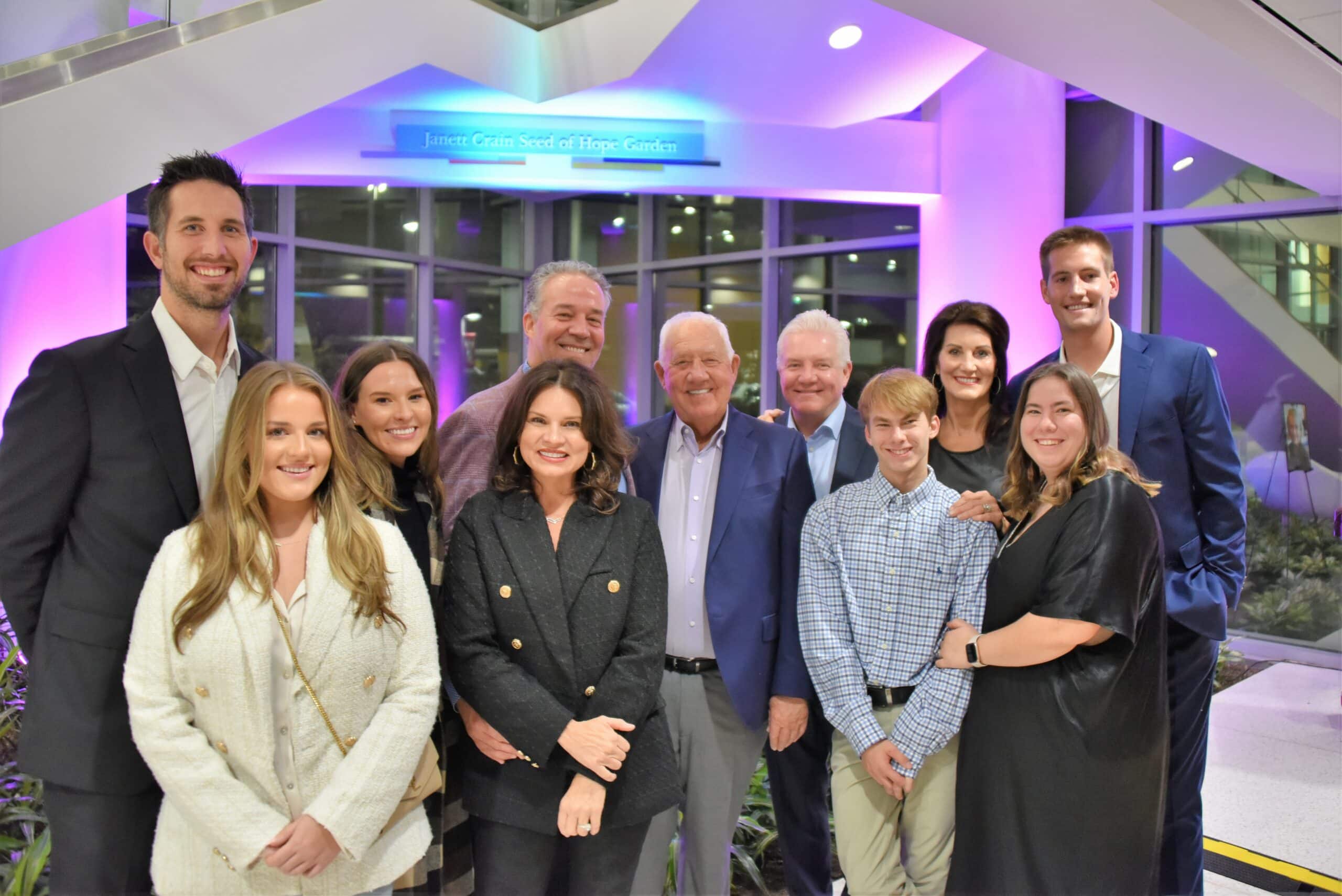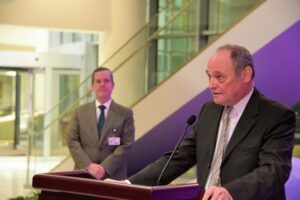View Larger Image

Several members of the Crain family joined Larry Crain (center in blue blazer) for the ceremony held at the UAMS Winthrop P. Rockefeller Cancer Institute.
Image by Andrew Vogler
UAMS Renames Seed of Hope Garden in Honor of the Late Janett Crain
| LITTLE ROCK — In what was an emotional and touching ceremony, the University of Arkansas for Medical Sciences (UAMS) honored the memory of Janett Crain by renaming the UAMS Winthrop P. Rockefeller Cancer Institute’s Seed of Hope Garden to the Janett Crain Seed of Hope Garden.
Larry Crain Sr., longtime friend and patron of UAMS, also was honored at the ceremony in recognition of his $1 million gift to the Cancer Institute, which he pledged in memory of his late wife who passed away in 2018 after a battle with cancer. Other members of the Crain family, including his children and grandchildren, joined him at the Dec. 8 ceremony.
“The Seed of Hope” is a sculpture by Little Rock artist Michael Warrick that is carved from a 3,700-pound piece of Turkish marble. The sculpture is a symbol of hope and healing for patients at the Cancer Institute. A small garden surrounds the sculpture in the lobby of the Cancer Institute.
It is a tradition at the Cancer Institute that on a patient’s final day of active treatment, they are presented with two seed-shaped tokens, one that is placed in the sculpture as a celebration of survivorship, while the second is taken with them to keep or pass on to someone else as their own symbol of hope. The Janett Crain Seed of Hope Garden is one of the most-visited areas in the Cancer Institute, and every instance of another patient placing their token in the sculpture is a celebration.
“The Seed of Hope Garden, now the Janett Crain Seed of Hope Garden, is a moment of respite for patients, families and UAMS staff as they deal with what are maybe the biggest challenges they will have to face in their lives,” said Cam Patterson, M.D., MBA, UAMS chancellor and CEO of UAMS Health. “I cannot think of anything better than for Janett Crain to be memorialized through this garden.”
Larry Crain’s gift provides critical resources for the Cancer Institute’s pursuit of National Cancer Institute (NCI) Designation, a highly competitive assessment process during which cancer centers must demonstrate outstanding depth and breadth of high-quality cancer research.

Michael Birrer, M.D., Ph.D., (podium) and Cam Patterson, M.D., MBA, addressed guests at the ceremony.Andrew Vogler
“The process required for NCI Designation is highly challenging, but it is critical for cancer patients in Arkansas — it will open UAMS to a high level of cancer services such as clinical trials and research so that no patient will have to leave the state for treatment,” said Michael Birrer, M.D., Ph.D., vice chancellor and director of the UAMS Cancer Institute. “To meet this designation, philanthropic gifts are critical in their flexibility, allowing us to lift up different areas in the Cancer Institute. We are extremely thankful for the Crains’ generosity because it will have an impact in providing cancer care to so many Arkansans.”
Crain is president of Crain Management Group LLC, a holding company with majority interests in a group of diversified companies. He earned his accounting degree from the University of Arkansas at Fayetteville in 1963 and joined Crain Automotive, Inc., a general merchandise and auto parts business begun by his father, Paul Crain, in 1966. Eventually that expanded into Crain Sales in Searcy, Arkansas. Over time, the company acquired other auto parts distribution businesses and expanded to 16 locations. In 1991, this expanded to auto dealerships.

Camryn Crain, granddaughter of Larry Crain, addresses guests as Cam Patterson, M.D., MBA, observes. A photo of Janett Crain was on display at the ceremony.Andrew Vogler
Larry and Janett Crain were high school sweethearts and married while attending the University of Arkansas at Fayetteville. Over the decades, Janett Crain served as a much-loved and respected mother figure to the Crain Automotive team. She was a schoolteacher and an active volunteer in her children’s schools and in the community. “Grandy,” as she was affectionately known by her nine grandchildren and four great-grandchildren, leaves a legacy as a mother and community volunteer that continues to live on.
“Grandy was simply magical, any environment that you were in with her was dreamlike,” said granddaughter Camryn Crain. “She was one of the most optimistic people that I knew — she was always choosing to look through the darkness, she always was looking at the light.”